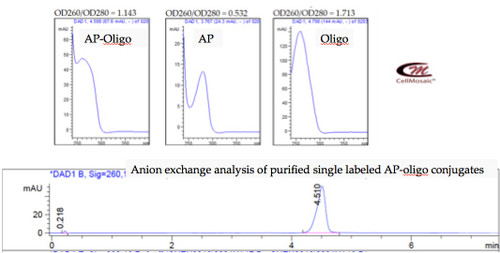Product Description
CellMosaic® offers bioconjugation research and development services for biopharmaceutical companies devoted to antisense and siRNA-based therapeutics.
Some of the obstacles to developing oligonucleotide analogs and siRNA-based therapeutics include limited cellular uptake, poor in vivo pharmacokinetic properties, and a lack of specificity for the target tissues/cells. New studies have shown that chemically conjugated oligonucleotide analogs and siRNAs with bioactive molecules, lipids, and polymers can overcome some of these limitations.
We prepare oligo-based conjugates using a unique conjugation strategy developed at CellMosaic®. PEG or other classical polymers can be conjugated anywhere on the oligo (3', 5', or via a modified base) in either the solid phase or post-synthesis solution phase. Usually a single pure conjugate can be obtained.
Advantages of CellMosaic's conjugation strategy:
- Freedom to attach a drug or molecule of interest at any point in the oligo.
- Other functional groups in the molecule, such as OH, NH2, and SH, will not be affected by the conjugation step.
- The conjugation strategy can easily be tweaked to couple different categories of compounds.
- Short timeline for the development of a conjugation strategy.
Case Studies:
- Delivery of antisense oligonucleotides with poly K peptide (oligo-peptide conjugate synthesized at CellMosaic®): peptide and oligo are linked together through a thiol ether bond. The conjugate has a characteristic UV spectrum of polyK peptide (205 nm) and oligo (260 nm).














